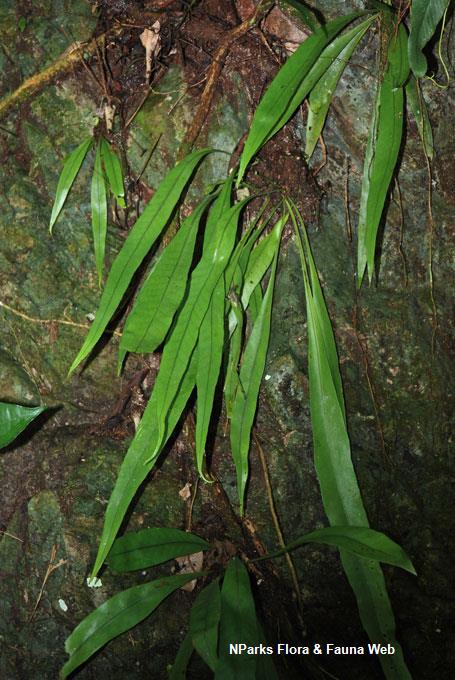.jpg)
Back
Microsorum punctatum 'Grandiceps'
| Family Name: | Polypodiaceae |
| Synonyms: | Polypodium punctatum 'Grandiceps' |
| Common Name: | Terrestrial Elkhorn Fern, Crested Fern, Fish-Tail Fern, Fishtail Strap Fern, Climbing Bird's Nest Fern, Dwarf Elkhorn Fern, 鱼尾星蕨 |
Name
Classifications and Characteristics
| Plant Division | Ferns & Lycophytes (Non-Seed Vascular Plants) (Fern) |
|---|---|
| Plant Growth Form | Epiphyte |
| Lifespan (in Singapore) | Perennial |
| Mode of Nutrition | Autotrophic |
| Maximum Height | 0.6 m |
| Maximum Plant Spread / Crown Width | 0.6 m |
Biogeography
| Native Habitat | Terrestrial |
|---|---|
| Preferred Climate Zone | Tropical |
Description and Ethnobotany
| Growth Form | Epiphytic, rhizomatous fern, able to grow up to 60 - 80 cm tall and 20 - 30 cm wide. |
|---|---|
| Foliage | Light green, glossy fronds are strap-like and leathery with entire or wavy leaf margin, measuring about 60 - 80 cm long and 5 - 10 cm wide. The frond consists of a single blade that forks into 2 parts repeatedly, forming a crested tip that resembles a fish's tail. The midrib is raised and highly prominent. |
| Stems | Has an underground horizontal stem known as a rhizome. |
| Reproductive Parts - non-flowering plant | Spores occur on the frond underside in small, dark brown spots. |
| Cultivation | This cultivar is fast-growing and requires little maintenance. Plant specimens 0.5 - 0.6 m apart in fertile, well-draining soil that is acidic to neutral (pH 5.5 - 7). Keep the soil consistently moist, but not soggy. Feed plants monthly with a water soluble fertilizer or apply a granular slow-release fertilizer annually. It grows best in a humid environment. Misting plants and grouping them together increases the humidity around them. Alternatively, potted plants can be placed on a bed of wet pebbles, but the standing water needs to be changed regularly to prevent mosquito breeding. This cultivar is susceptible to mealy bugs and scale insects. |
| Etymology | The genus "Microsorum" is derived from the Greek word for small ("mikros") and the spore-containing structure known as sorus.. It refers to the small sori of Microsorum punctatum which is the type species of this genus. The species epithet "punctatum" refers to the small pits that occur in the fronds of the parent species Microsporum punctatum and cultivar 'Grandiceps.' |
Landscaping Features
| Landscaping | This cultivar is grown for its ornamental foliage. It is suitable for container plantings and may be placed indoors or outdoors. |
|---|---|
| Desirable Plant Features | Ornamental Foliage |
| Landscape Uses | Container Planting, Interiorscape/ Indoor Plant |
Fauna, Pollination and Dispersal
| Seed or Spore Dispersal | Abiotic |
|---|
Plant Care and Propagation
| Light Preference | Semi-Shade |
|---|---|
| Water Preference | Moderate Water |
| Plant Growth Rate | Moderate |
| Rootzone Tolerance | Fertile Loamy Soils, Well-Drained Soils, Shallow Media |
| Maintenance Requirements | Moderate |
| Propagation Method | Division, Spore |
| Propagation Method Remarks | Propagate by spores, rhizome cuttings or dividing plants. Spores collected from the frond underside are dried in an envelope and then germinated on moistened peat moss in a dim, humid spot. Germination may require a few months to occur. |
| Planting Distance | 0 to 0 |
Foliar
| Foliage Retention | Evergreen |
|---|---|
| Mature Foliage Colour(s) | Green |
| Mature Foliage Texture(s) | Smooth, Glossy / Shiny, Leathery |
| Foliar Type | Simple / Unifoliate |
| Foliar Venation | Dichotomous |
| Foliar Margin | Entire - Wavy / Undulate |
| Foliar Apex - Tip | Acute |
| Foliar Base | Truncate / Square |
| Typical Foliar Area | Macrophyll ( 182.25cm2 - 1640.25 cm2 ) |
Image Repository
Others
| Master ID | 256 |
|---|---|
| Species ID | 1552 |
| Flora Disclaimer | The information in this website has been compiled from reliable sources, such as reference works on medicinal plants. It is not a substitute for medical advice or treatment and NParks does not purport to provide any medical advice. Readers should always consult his/her physician before using or consuming a plant for medicinal purposes. |

.jpg)


.jpg)





